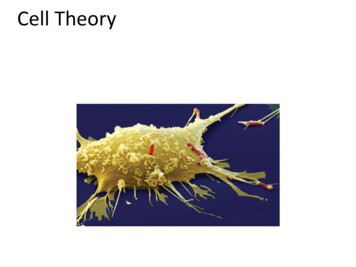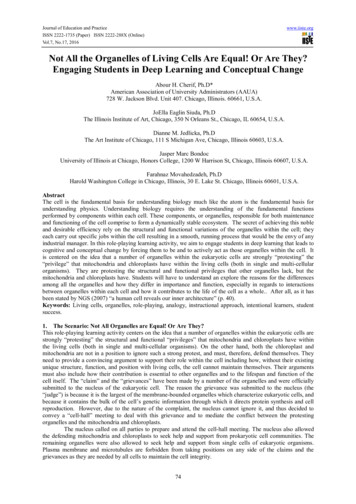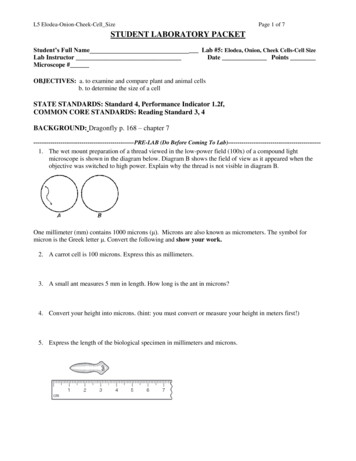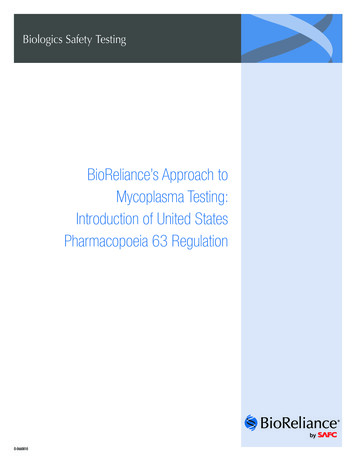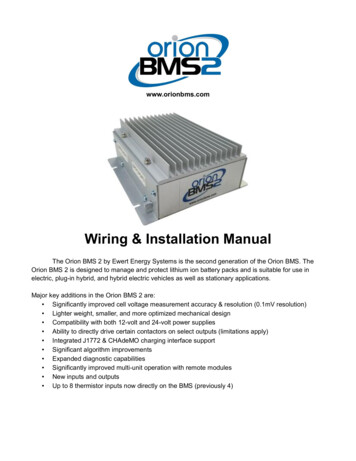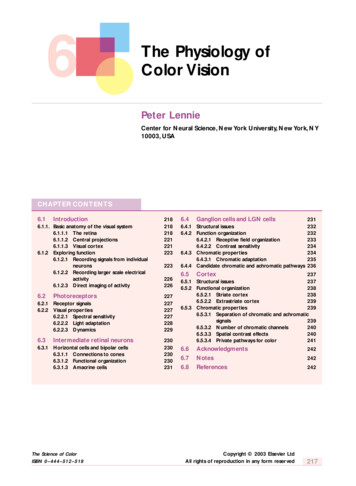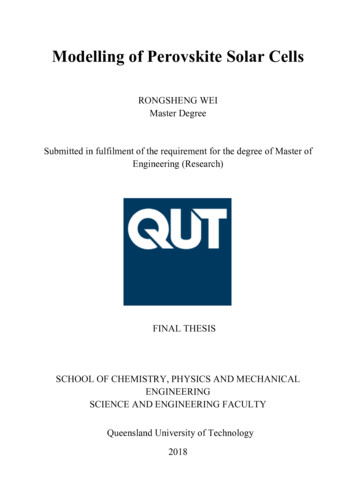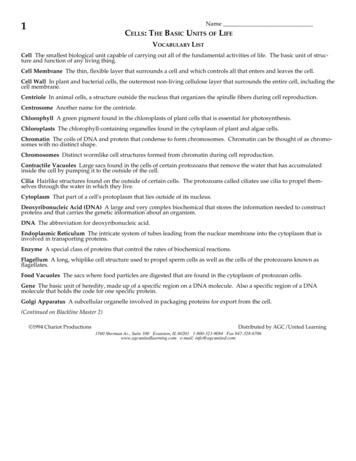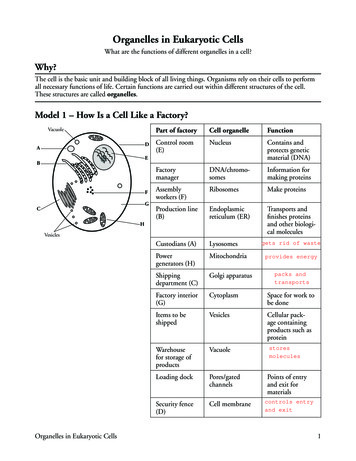
Transcription
Organelles in Eukaryotic CellsWhat are the functions of different organelles in a cell?Why?The cell is the basic unit and building block of all living things. Organisms rely on their cells to performall necessary functions of life. Certain functions are carried out within different structures of the cell.These structures are called organelles.Model 1 – How Is a Cell Like a Factory?VacuoleDAPart of factoryCell organelleFunctionControl room(E)NucleusContains andprotects geneticmaterial (DNA)FactorymanagerDNA/chromosomesInformation formaking proteinsAssemblyworkers (F)RibosomesMake proteinsProduction line(B)Endoplasmicreticulum (ER)Transports andfinishes proteinsand other biological moleculesCustodians (A)LysosomesPowergenerators (H)MitochondriaShippingdepartment (C)Golgi apparatusFactory interior(G)CytoplasmSpace for work tobe doneItems to beshippedVesiclesCellular package containingproducts such asproteinWarehousefor storage ofproductsVacuoleLoading dockPores/gatedchannelsSecurity fence(D)Cell membraneEBFGCHVesiclesOrganelles in Eukaryotic Cellsgets rid of wasteprovides energypacks andtransportsstoresmoleculesPoints of entryand exit formaterialscontrols entryand exit1
1. Using the letters from the table in Model 1, label the cell diagram with the organelle names.2. According to the table,a. what substance is analogous to a factory manager?DNAb. in what organelle would this substance be found?Nucleus3. Using the information in Question 2, which cell organelle controls the activities of the entire cell?Nucleus4. Which organelle generates energy to power cellular activities?Mitochondria5. Which organelle is responsible for assembling proteins?Ribosomes6. Once proteins have been assembled, to which organelle would they go next?Rough ER7. Into what organelle might the cellular products be placed?Vacuole8. Fill in the missing functions of cellular organelles in the table in Model 1.9. Starting with instructions from the factory manager (DNA/chromosomes), create a flow chart toshow how a protein is produced and shipped from a cell.DNA in Nucleus2Rough ERGolgiCell MembranePOGIL Activities for High School Biology
Model 2 – Animal Cells with Organelle(s) RemovedCell 1Cell 2Cell 3Cell 4Cell 5Cell 6Cell 7Cell 8Cell 9Organelles in Eukaryotic Cells3
10. Study the cells in Model 2. Which cell is not missing any organelles compared to Model 1?Cell 911. Look carefully at Cell 2 in Model 2. Compared to Model 1, what kind of organelle is missing?Mitochondria12. Using grammatically correct sentences, describe why Cell 2 would not function normally.Cell 2 would not have energy to function.13. Which two cells in Model 2 will have difficulty containing and getting rid of wastes within thecell? Why?Cells 5 and 6 because they are missing lysosomes.14. Cell 1 is missing one organelle. List as many reasons as possible why Cell 1 will not survive.Cell one has no nucleus or DNA. Thus,it will not be able to create proteinsor control any actions or properties ofthe cell.15. Cell 4 and Cell 7 will not be able to synthesize a major biological molecule. What molecule isthis?These cells have no ribosomes. Consequently,they will not be able to build any proteins.4POGIL Activities for High School Biology
Model 3 – Animal Cell vs. Plant CellAnimal CellPlant CellCentralVacuoleChloroplastCell Wall16. Do both cells in Model 3 have a nucleus?Yes17. Do both cells in Model 3 have mitochondria?Yes18. Describe at least three differences between the animal and plant cells shown in Model 3.Plant cells have a cell wall, chloroplasts and a large vacuole.Additionally plant cells are more of a box shape because oftheir rigid cell wall.Organelles in Eukaryotic Cells5
Read This!Plant cells have three organelles not found in animal cells. They include the cell wall, large centralvacuole, and plastids (including chloroplasts).19. Complete the table below using the three plant organelles mentioned in the Read This! box.OrganelleVacuoleCell WallChloroplastsFunctionFluid-filled organelle stores water, enzymes, and waste products.Size of this organelle can change.Supports and protects the cell.Some store food or pigments; some convert light energy tochemical energy in the form of organic compounds.20. Label each of these three organelles on the plant cell diagram in Model 3.21. Individually, in one grammatically correct sentence, describe why it is necessary for plants to havechloroplasts.Plants have chloroplasts to produce carbohydrate because they haveno other way to get food.22. As a group, reach a consensus on the answer to Question 21. Record the answer below.N/A23. The central vacuole stores water. What would happen to the size of the central vacuole if a plantdoes not have enough water?The plant would dehydrate and wilt (shrivel).24. Describe the appearance of the vacuole in a well-watered plant. What effect would this have onthe cell wall of the plant?The vacuole would be full and large not shrivelled.would be plump, not wilted.The plant25. Using your response to Question 24, construct an explanation for why a plant has both a rigidcell wall and a cellular membrane.The cell wall keeps the shape of the cell and plant. The cellmembrane controls the entry and exit of nutrients and waste.6POGIL Activities for High School Biology
Extension QuestionsRead This!All cells undergo cellular respiration for the production of energy. Energy is necessary for all metabolicactivity within the cell.The formula for cellular respiration isC6H12O6 6O2 6CO2 6H2O energy/ATPPlants carry out photosynthesis for the production of glucose. The glucose then becomes the energysource for cellular respiration.The formula for photosynthesis isSun’s energy6CO2 6H2O C6H12O6 6O226. Study the information given in the Read This! box.a. In what organelle does cellular respiration occur?Mitochondriab. Do plant and animal cells both have this structure?Both plant and animal cells need energy/ATP.27. In what organelle does photosynthesis occur? Do plant and animal cells both have this structure?Chloropolasts which are only found in plant cells.28. Using the equations above, explain the relationship between mitochondria and chloroplasts.Chloroplasts make carbohydrates and mitochondriaconvert the carbohydrates into energy/ATP.29. Plants have both mitochondria and chloroplasts; they can produce their own glucose to fuelcellular respiration. Animal cells, on the other hand, have only mitochondria. If an animal eatsonly meat what would be its source of glucose?The glucose that has not been broken down yet in theanimal tissue. This would probably not be a sufficientsource of glucose.30. Where in the human body would you find cells with a large number of mitochondria? Why?I would expect a lot of mitochondria in muscle tissue.Muscles take a lot of energy to contract, the mitochondriasupply energy.Organelles in Eukaryotic Cells7
21. Individually, in one grammatically correct sentence, describe why it is necessary for plants to have chloroplasts. 22. As a group, reach a consensus on the answer to Question 21. Record the answer below. 23. The central vacuole stores water. What would happen to the size of the central vacuole if a plant does not have enough water? 24.
